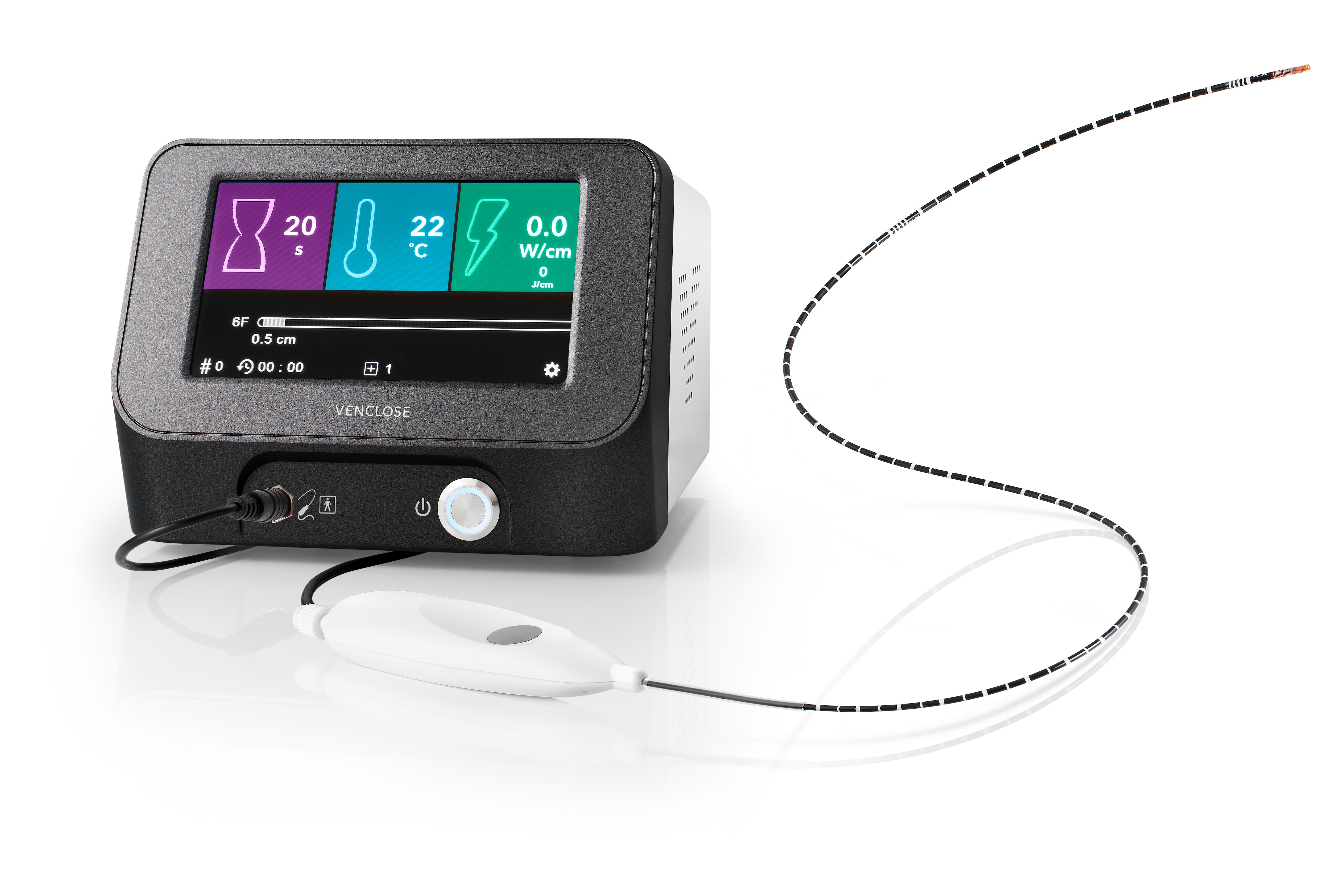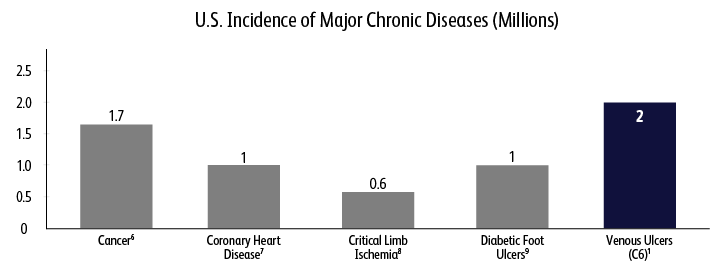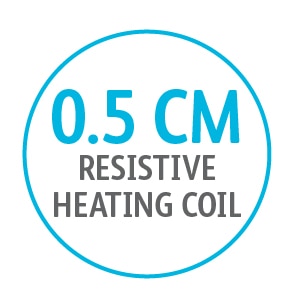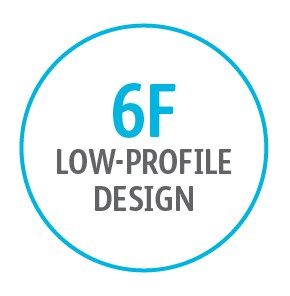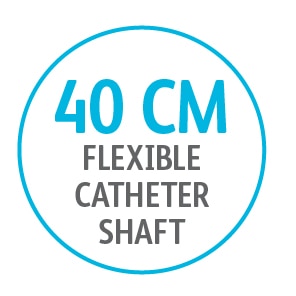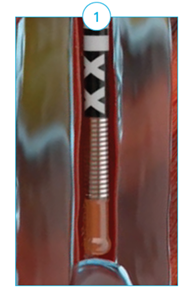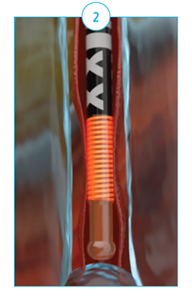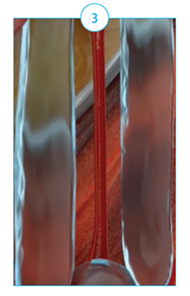Venclose Maven™ Perforator Catheter
Safety and Risk Information
Indication for Use
The Venclose Maven™ Perforator Catheter is intended for endovascular coagulation of blood vessels in patients with perforator and tributary vein reflux.
Contraindications
The Venclose Maven™ Perforator Catheter is contraindicated in patients with thrombus in the vein segment to be treated.
Warnings
Potential impact to active implanted medical devices located nearby the intended treatment location in the lower limbs has not been evaluated. It is recommended not to coil the Venclose Maven™ connector cable directly above active implanted medical devices • The Venclose™ system is not intended to be used with magnetic resonance imaging • Thermal treatment of the vein may damage adjacent sensory or motor nerves. Risk of damage is greater near the calf or if no local anesthetic is used around the treated vein • Treatment of a vein located close to the skin surface may result in a skin burn. Ensure that the proximal end of the heating element is at least 0.5 cm from the skin • Do not treat within the deep venous system. Ensure that the distal tip of the catheter is greater than 0.5 cm from the deep venous system • Treatment of a vein located near the skin surface may result in a skin burn if the skin is not protected with fluid infiltration • Care should be taken to preserve adequate blood circulation, especially for patients with documented peripheral arterial disease • Catheter is for single patient use only. A contaminated catheter may lead to illness or death of the patient. Cleaning damage to the catheter may lead to ineffective treatment or injury. Venclose™ will not be responsible for any direct, indirect, incidental or consequential damages or expenses resulting from reuse of the catheter • Transcutaneous ultrasound imaging is recommended to confirm and maintain device tip and heating element position in the target vessel. Do not place heating element in a vein valve (for the purpose of restoring valve function) or in the deep venous system • If electromagnetic interference associated with stray energy from the digiRF™ System is encountered, reposition the imaging system and/or the digiRF™ Generator to eliminate such interference. See the “Separations Distances” table in Section 12 in the digiRF™ Generator’s User Manual for further information • Nerve injury may occur from thermal damage to adjacent sensory nerves. Risk of nerve injury may be higher with treatment at or below the calf, or without perivenous fluid infiltration • Flammable agents for cleaning, disinfecting, or as solvents of adhesives shall be allowed to evaporate before using the Venclose™ system • Interference caused by use of the Venclose™ system may adversely influence operation of other electronic equipment.
Precautions
Store in a dry, cool place • Do not bend catheter shaft into a tight radius; kinking of the shaft may render the catheter inoperable • To prevent damage to the guidewire, ensure that the guidewire does not protrude from the catheter tip when inserting catheter into vein • If fluid contacts the Venclose Maven™ cable connector, wipe it clean and dry before inserting into the generator • Do not leave the guidewire within the catheter lumen at the heating element location during treatment as it will cause the guidewire to become stuck within the catheter lumen • Do not advance the catheter against resistance, or vein perforation may occur • Uneven blood pooling or flow along the heating element may result in inconsistent effectiveness and/or may damage the catheter • Do not begin treatment without verifying that the length of heating element that will actively heat remains inserted a length of at least 0.5 cm from the vein access point • The portion of the catheter shaft within 2.0 cm of the heating element may exceed 41 ºC during treatment. Testing of this region has shown that a maximum temperature of 42 ºC can be reached • If the generator stops treatment due to improper heating, remove the catheter and inspect. Replace the catheter if damage is found. Failure to respond to advisory indicators can result in damage to the catheter • If using direct external compression, do not compress the skin closer than 0.5 cm to the heating element or a skin burn may occur • Do not re-advance the catheter and re-treat an acutely treated vein section or it may increase risk of embolism • Do not treat with the heating element within the access sheath or closer than 0.5 cm to the point of skin access or a skin burn, catheter damage or sheath damage may result • The vein wall may be thinner in an aneurysmal segment. To effectively occlude a vein with an aneurysmal segment, additional compression may be needed over the aneurysmal segment, and the treatment of the vein should include segments proximal and distal to the aneurysmal segment • Use of a flush through the catheter while the heating element is active will interfere with treatment and heat the fluid exiting the end of the catheter. Avoid fluid delivery through the catheter when tip of catheter is near an area that should not be thermally coagulated • Failure to evenly compress the vein over the full length of the heating element may result in inconsistent effectiveness and/or possible catheter damage • Place monitoring electrodes as far as possible from the Venclose™ catheter when the digiRF™ Generator and physiological monitoring equipment are used simultaneously on the same patient • Do not use needle monitoring electrodes • Use monitoring systems incorporating high frequency current-limiting devices • There is a risk of pooling of flammable solutions under the patient, or in body depressions such as the umbilicus, and in body cavities such as the vagina. These fluids should be mopped up before using the Venclose™ system • Endogenous gases (e.g., cotton and gauze saturated with oxygen) may be ignited by sparks produced within the generator during normal use of the Venclose™ system • The Venclose™ system is for use without a neutral electrode • The patient should not come into contact with grounded conductive components or conductive components with appreciable capacitance to earth, such as metallic operating table supports • Do not begin energy delivery (by pressing the catheter handle button or a connected foot switch) before the catheter is properly positioned within the intended treatment vessel and anesthesia is administered, or discomfort or injury may occur • Avoid contact of cords and cables with patient, lead, or other equipment.
Potential Adverse Events
Potential adverse events include, but are not limited to the following: vessel perforation • skin discoloration • nerve injury • temporary paresthesia • thrombosis • deep vein thrombosis • phlebitis • hematoma • infection • skin burn • pulmonary embolism • pain
digiRF™ Generator
Safety and Risk Information
Intended Use
The Venclose™ digiRF™ Generator is intended to be used with Venclose™ RF Catheter(s) as a system.
Contraindications
The Venclose™ System is contraindicated in patients with thrombus in the vein segment to be treated.
Warnings
Potential impact to active implanted medical devices located nearby the intended treatment location in the lower limbs has not been evaluated. It is recommended not to coil the catheter connector cable directly above active implanted medical devices • The Venclose™ system is not intended to be used with magnetic resonance imaging • Thermal treatment of the vein may damage adjacent sensory or motor nerves. Risk of damage is greater near the calf or if no local anesthetic is used around the treated vein • (VC-10A2.5-6F-60, VC-10A2.5-6F-100) Treatment of a vein section closer than 1 cm to the skin may result in a skin burn. Direct external compression may reduce the distance between the vein and skin • (VC-0.5-6F) Treatment of a vein located close to the skin surface may result in a skin burn. Ensure that the proximal end of the heating element is at least 0.5 cm from the skin • (VC-0.5-6F) Do not treat within the deep venous system. Ensure that the distal tip of the catheter is greater than 0.5 cm from the deep venous system • Treatment of vein located near the skin surface may result in a skin burn if the skin is not protected with fluid infiltration • Care should be taken to preserve adequate blood circulation, especially for patients with documented peripheral arterial disease • Nerve injury may occur from thermal damage to adjacent sensory nerves. Risk of nerve injury may be higher with the treatment at or below the calf, or without perivenous fluid infiltration • Verify that the generator successfully starts up and shows the home screen before beginning a medical procedure that requires its use • Do not operate the digiRF™ Generator in the presence of flammable gasses such as anesthetic mixtures with oxygen, nitrous oxide or air, or in contact with flammable materials or chemicals such as isopropyl alcohol • Do not operate the digiRF™ Generator in a moist environment or a shock hazard may exist • Flammable agents for cleaning, disinfecting, or as solvents of adhesives shall be allowed to evaporate before using the Venclose™ System • Interference caused by use of the Venclose™ System may adversely influence operation of other electronic equipment • Failure of the Venclose™ System could result in an unintended increase of output power • The digiRF™ Generator must be plugged into a supply mains with protective earth ground. Do not use a 3-to-2 prong plug converter to eliminate the ground connection. For 240 V supply mains, only use an AC power center-tap configuration for single phase circuit. Do not remove the cover of the digiRF™ Generator • Use the digiRF™ Generator only with genuine Venclose™ RF Catheters. DO NOT use catheters from any other manufacturer with the digiRF™ Generator as this may damage the generator, increase emissions, decrease immunity to interference, or injure the patient or user • Unplug the digiRF™ Generator power cord from the mains power outlet before checking the fuses • (VC-10A2.5-6F-60, VC10A2.5-6F-100)Transcutaneous ultrasound imaging is recommended to confirm and maintain device tip and heating element position in the target superficial vessel. Do not place heating element in a vein valve (for the purpose of restoring valve function), a perforating or non-superficial communicating vein, or in the deep venous system • (VC-0.5-6F) Transcutaneous ultrasound imaging is recommended to confirm and maintain device tip and heating element position in the target vessel. Do not place heating element in a vein valve (for the purpose of restoring valve function) or in the deep venous system • If electromagnetic interference associated with stray energy from the digiRF™ Generator is encountered, reposition the imaging system and/or digiRF™ Generator to eliminate such interference. See the “Separations Distances” table in Section 12 for further information (table can be found in the User Manual) • If treatment does not halt automatically, disconnect the device • Proper ESD precautionary procedures should be used when handling, inserting, or removing the SD card.
Precautions
Do not stack other equipment on top of the digiRF™ Generator • The digiRF™ Generator has no user-serviceable internal parts. If repair is needed, return the generator to an authorized Venclose™ service facility. A loaner generator may be provided while the generator is away for service. Contact Customer Service for the location of the nearest service facility or for information on receiving a loaner unit • Do not touch the digiRF™ Generator and the patient simultaneously • Place monitoring electrodes as far as possible from the Venclose™ catheter when the digiRF™ Generator and physiological monitoring equipment are used simultaneously on the same patient • Do not use needle monitoring electrodes • Use monitoring systems incorporating high frequency current-limiting devices • There is a risk of pooling of flammable solutions under the patient, or in body depressions such as the umbilicus, and in body cavities such as the vagina. These fluids should be mopped up before using the Venclose™ System • Endogenous gases (e.g., cotton and gauze saturated with oxygen) may be ignited by sparks produced during normal use of the Venclose™ System • The Venclose™ System is for use without a neutral electrode • Do not use sharp objects or harsh cleaning agents that may damage the digiRF™ Generator touch screen • Do not remove the cover of the digiRF™ Generator; removal of the cover voids the warranty • Replace the digiRF™ Generator fuses only with the appropriate type and rating as identified at the fuse location • The patient should not come into contact with grounded conductive components or conductive components with appreciable capacitance to earth, such as metallic operating table supports • Use both hands when carrying the digiRF™ Generator; do not drop the generator • Inspect the digiRF™ Generator power cord often for visible signs of damage and do not use a damaged power cord as it may cause patient or user injury • The digiRF™ Generator should be allowed to reach the temperature of the room in which the Venclose™ system procedure will be performed before any treatment is started. Failure to equalize temperature may interfere with proper temperature reading and cause excessive or insufficient treatments • Do not begin energy delivery (by pressing the catheter handle button or a connected foot switch) before the catheter is properly positioned within the intended treatment vessel and anesthesia is administered, or discomfort or injury may occur • Avoid contact of power cord and cable with patient, lead, or other equipment • The vein wall may be thinner in an aneurysmal segment. To effectively occlude a vein with an aneurysmal segment, additional compression may be needed over the aneurysmal segment, and the treatment of the vein should include segments proximal and distal to the aneurysmal segment.
Potential Adverse Events
Potential adverse events related to the use of ablation systems include, but are not limited to, the following: • Thrombus/embolic event • Deep vein thrombosis • Pulmonary embolism • Skin burns • Nerve damage • Temporary paresthesia • Hyperpigmentation • Hematoma • Vessel perforation • Phlebitis • Infection • Pain
BD, the BD logo, digiRF, Venclose, and Venclose Maven are trademarks of Becton, Dickinson and Company or its affiliates. © 2022 BD. All rights reserved. | 1 800 321 4254 | www.bd.com | Tempe, AZ 85281, MK00002.F
BD-57732v3


